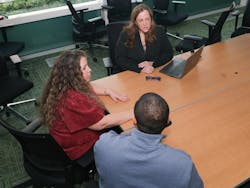Executive Insights with Angie Bailey, Director of the N.C. Department of Information Technology’s Broadband Infrastructure Office
As broadband providers navigate the challenges of expanding connectivity to rural and underserved areas, North Carolina offers a blueprint for success. The state is making significant strides in bridging the digital divide through innovative funding solutions, a commitment to emerging technologies and a collective vision for what is right.
With $2.5 billion in investments and a focus on affordability, Angie shares critical insights about the importance of flexible program designs, robust data mapping and hybrid networks. She is a leader who showcases how collaboration and innovation can drive transformative change in today’s complex environment of building broadband networks that stand the test of time.
Topic: The Rural Business Case
ISE: With North Carolina having the second largest rural population in the country, broadband connectivity remains a significant challenge. The N.C. Department of Information Technology’s Broadband Infrastructure Office must help broadband network providers justify the business case to serve sparsely populated areas. What are two creative solutions to this problem?
Angie Bailey: The solution to deploy high-speed internet to sparsely populated areas isn’t creative; it is financial. Broadband providers must be able to see a return on investment for building to locations and bringing them broadband. They want customers, but subscription rates must offset the required capital expenditures and operating costs. For many sparsely populated areas, it takes state and federal investments to offset capital costs and incent companies to build to these locations. With more people working remotely and activities like online schooling and telehealth since the pandemic, we have seen a significant shift in willingness to invest these funds to ensure connectivity for our communities. Infrastructure in rural areas requires a willingness to invest in the economic future of these communities. With the combination of funds from the American Rescue Plan Act (ARPA), the Broadband Equity, Access, and Deployment (BEAD) program, the work of our Governor’s office and the legislature, North Carolina is investing over $2.5 billion in last-mile infrastructure.
We are seeing tremendous pressure on our broadband providers to take advantage of this unprecedented funding opportunity to expand access to our unserved and underserved areas in finite amounts of time. We can’t risk losing this opportunity to make the most of these infrastructure investments for each community by rushing the process.
Topic: Hybrid Networks
ISE: What is your team’s recommendation for emerging technologies like 5G, satellite, and fixed wireless to complement traditional broadband deployment?
Bailey: There is no one solution for providing connectivity. Different households, businesses, and communities may have differing needs and budgets. Many will subscribe to multiple technologies at once, such as homes with fiber plus mobile service for their residents. Satellite can be quick to implement and has been essential for us in emergency operations. Multiple technology types are important in this landscape to meet different purposes and provide options.
Topic: Lessons Learned
ISE: You’ve coordinated statewide programs and partnerships with broadband providers for many years. Your team has led several impactful programs, including ARPA, GREAT (Growing Rural Economies with Access to Technology), CAB (Completing Access to Broadband), Stop-Gap Solutions, and Pole Replacement. What are three best practices you recommend for improving partnership programs with community-based network providers?
Bailey:
- Develop workable programs for broadband providers and funding agencies and have some flexibility for both parties. For example, providers need to be able to bid on locations that they can serve. Too many requirements will decrease participation in the program, and for funding agencies, too many requirements can make it impossible to award funds.
- Spend the time and resources needed on mapping and data work. The foundation of any publicly funded broadband infrastructure program is managing and mapping data on the availability status of locations across the state. Typically, with state and federal money, you can only fund a location once and can primarily fund only locations that are unserved or underserved with broadband. The FCC and the broadband providers have done a tremendous job of moving to location-level availability data in the last few years. However, states must still invest time and effort refining this data with their broadband partners. We have partnered with the state’s Center for Geographic Information and Analysis and the Friday Institute at NC State University to submit challenges to the FCC’s National Broadband Map, which aided in surfacing 115,000 additional North Carolina homes and businesses that do not have access to high-speed internet. This effort added more new unserved locations to the map through this process than any other state and increased our funding allocation from the BEAD program.
- Ensure your state focuses on adoption and digital literacy efforts. Our partner office—the Office of Digital Opportunity—focuses on adoption, digital navigation and digital literacy, device distribution, and affordability. Infrastructure cannot continue to be deployed or maintained without people subscribing to the service. The more subscribers, the more companies can further deploy. These efforts are a critical component of any state’s broadband program.
ISE: Conversely, what are two practices others should avoid?
Bailey:
- Don’t create programs without input from providers. Maintain ongoing communication with broadband providers of all types to understand what programs will work for them from a business standpoint.
- Don’t create too many programs if they can accomplish the same thing! We have been fortunate in North Carolina to have multiple last-mile broadband infrastructure programs funded by the ARPA and now the BEAD program. If these programs could be combined into one deployment program, we could move more quickly to get funding out the door and start projects. But we have learned best practices from each program and appreciate the investment being made by the state for our residents and businesses.
Topic: Managing Expectations
ISE: Public and political pressure to deliver broadband quickly can clash with the reality of multi-year infrastructure projects. How do you effectively manage expectations and communicate project timelines to stakeholders?
Bailey: Be transparent with state leaders and stakeholders from the start that infrastructure projects take time to build. We are seeing tremendous pressure on our broadband providers to take advantage of this unprecedented funding opportunity to expand access to our unserved and underserved areas in finite amounts of time. We can’t risk losing this opportunity to make the most of these infrastructure investments for each community by rushing the process. An enormous amount of broadband deployment is happening across our state, with both publicly funded and privately funded infrastructure projects. We see results daily and in each iteration of FCC broadband data released. Maintain clear communications on the status of the deployment programs and accurate timelines.
We hold monthly meetings with individual stakeholder groups, host live webinars and in-person town halls and share publicly available maps and dashboards showing project statuses and completion deadlines. We also communicate frequently with the governor’s administration and legislators to keep them apprised.
Topic: The Elephant in the Room
ISE: What is the broadband industry not addressing that it should be?
Bailey: Recovery from natural disasters is still somewhat uncharted territory for broadband providers, the communities they serve, and local, state, and federal leaders who work to rebuild areas after disasters. Rebuilding damaged infrastructure involves a complicated mix of players—last-mile broadband providers, middle-mile providers, utility companies, and pole owners—who may all have different processes for assessing damage and seeking reimbursement. These entities likely need to coordinate with states’ departments of transportation on road damages and with permitting entities.
Processes for rebuilding “telephone” may be different than “broadband.” It can take time to update data on locations in an area and the new availability status of locations. If a neighborhood had multiple providers serving it, will funds be invested to build back competition in the neighborhood? Should rebuilding include building with stronger technologies or more redundancy, depending on who is funding the rebuilds? There are a lot of questions to sift through with broadband providers and state and federal leaders to find the models and best practices in this space.
Topic: The Clock Ticks
ISE: BEAD regulations require the $1.53 billion awarded on October 10, 2024, to be allocated within 365 days. Realistically, is this timeline achievable? If not, what would be a better approach?
Bailey: Because the BEAD program aims to reach 100% of unserved and underserved locations, it requires a very different approach than other broadband grant programs. States receive applications from broadband providers to serve specific locations but then must negotiate with broadband providers to identify solutions for the remaining unserved and underserved broadband serviceable locations.
North Carolina has the second-largest rural population in the country, one of the largest ARPA funds appropriations for broadband deployments, and the largest number of broadband programs. Fortunately, our governor and legislature are committed to broadband solutions for the state. For the BEAD program, states should be given more leeway to determine the timing of their BEAD subgrantee selection, best encompassing the program and its many federal program requirements.
Topic: Navigating Bureaucracy
ISE: Deploying broadband to the last house on the farthest dirt road in rough terrain demands deployment challenges. The process requires navigating complex state and local regulations, including permitting, rights-of-way, and environmental reviews. How can your team help reduce these challenges to keep projects on track?
Bailey: We maintain strong relationships and communication with the N.C. Department of Transportation and coordinate with them on publicly funded project locations and timelines. We have held joint webinars to ensure broadband providers understand the permitting processes. We also ask our funded awardees to report on the status of easements and permits as part of their quarterly progress reports so we can flag any potential delays. While we can’t necessarily change the required processes, we can create effective communication channels to ensure broadband providers understand what to anticipate and permitting agencies know about the upcoming workload. This is critical so the agencies responsible for processing these requests can ensure adequate staffing capacity.
Topic: Predicting the Unpredictable
ISE: Labor shortages, weather delays, and other unforeseen factors can disrupt deployment timelines. How does your team plan to ensure consistency in network deployment project timelines?
Bailey: Unpredictable events are a real thing that can’t always be anticipated. North Carolina experienced a significant natural disaster in the fall with Hurricane Helene, which devastated many communities in the western part of the state. While we obviously require construction timelines in our award agreements, projects can be delayed at no fault of the broadband providers. Programs need to allow for realistic timelines and allow some flexibility for unforeseen or unavoidable circumstances. That’s why we consider extension requests when necessary. We don’t want to rush taxpayer-funded projects and create risks of failure or termination before the project can reasonably be completed. As such, North Carolina currently has requests submitted to the U.S. Department of the Treasury for an extension of the deadlines for projects funded by the ARPA.
Topic: The Future
ISE: What emerging or disruptive broadband technology excites you the most, and why?
Bailey: Certainly, Low Earth Orbit satellites are the most intriguing as a new space in broadband connectivity. They carry additional capacity and higher speeds than earlier satellite products and can reach areas not accessible by other technologies. This technology was extremely helpful in western North Carolina with emergency operations during Hurricane Helene, both for internet connectivity and VoIP. In some cases, it was the only communication method available. Low Earth Orbit satellites can be a critical source of redundancy during emergencies, but managing a network of satellites is still a relatively new technology with few providers. It is important to understand the benefits and limitations of different technology types, and ideally, the market will match the technology type with the most useful purposes.
Topic: Optimizing Networks
ISE: Network providers face increasing pressure to optimize networks while also maintaining network security. How do you encourage providers to build future-proof networks, and how do you monitor these networks?
Bailey: When we evaluate broadband providers and their projects, our most critical evaluation criterion is the “ability to perform.” We look at broadband providers’ years of experience, experience with a particular technology, past performance (especially on publicly funded projects), financial solvency, and ability to provide matching funds. We don’t want to micromanage the network design, traffic management, use of AI, or network security.
To us, the companies are best suited to navigate that space. However, we need broadband providers that have experience and capacity to ensure they can implement the necessary network management requirements, including modernization and security. That’s why experience, past performance and financial solvency are key criteria.
Topic: Workforce Challenges
ISE: Today’s limited workforce skilled in broadband deployment (e.g., fiber installation, network engineering, construction) could strain states’ abilities to meet BEAD deliverables. What is your team doing to help with this?
Bailey: When we created our workforce development plan for the BEAD program, we included input from a committee of stakeholders like internet service providers, fiber manufacturers, the Communications Workers of America, the state Department of Public Instruction, the NCWorks Commission, the community college system, community-based organizations and national broadband employer associations. The plan outlines our strategies to address workforce needs, including creating a career pathway to map on-ramps to entry-level broadband jobs with career advancement opportunities, developing regional training hubs at community colleges to offer fiber technician credentials, working with school districts to create career accelerators and dual enrollment on-ramps for high school students, and promoting apprenticeships.
ISE: Is there anything we haven’t covered?
Bailey: I want to stress the importance of affordability as a factor in ensuring connectivity across our state and others. North Carolina was a big participant in the Affordable Connectivity Program (ACP)—we had more than 901,000 participating households. Broadband providers are big supporters of the ACP, and we need consumers to subscribe to high-speed internet service to keep deploying and maintaining networks. We know that different technology types have different investment costs and, therefore, different costs in service plans. Other factors can contribute to costs such as changes in the content space with more streaming services, infrastructure changes, and the ability to retire old infrastructure. Many factors are at play, but we hope that a program like ACP can be implemented to help consumers afford to subscribe so they can access crucial things like online learning, job applications, government services, telehealth and more.
Topic: Paying It Forward
ISE: Share three pieces of advice for leaders who want to follow your path.
Bailey: Choose to follow the path of something you are passionate about so you can wake up each day excited to contribute.
Build the team you need. Our work in North Carolina would not be possible without our team. I am very intentional about recruitment and work with the team to maximize their skill sets to meet the office's mission and goals. I encourage our folks to work in teams because everyone has different perspectives to offer. We are solving complex problems, so I urge the team to share ideas, listen, choose a path, and move forward.
Stay focused, set your energy for each day, and be clear on what you want to and need to accomplish. Block out the noise. Don’t let it take you off course or distract you.
Topic: Significant Risks
ISE: What is your most significant professional risk, and what did you learn from it?
Bailey: There is risk in being afraid to tackle difficult things. This work is complicated and not static. Don’t fear change, complex issues, conflict, or debate. There may not be one finite solution to a problem, so choose a path and tackle it. Keep moving. Big challenges require continued dedication, flexibility, and perseverance.
Topic: Constant Growth
ISE: Leaders must continually improve. What skills or knowledge must you acquire or build to achieve your goals?
Bailey: My son is an athlete, and we are reading a book about mental toughness by Moses and Troy Horne. Knowledge is always available and absorbable. Leaders must be willing to grow their personal capabilities to take on what is needed, whether it is navigating expectations and timelines, coordinating relationships with stakeholders, or encouraging their teams. Mental toughness is required to balance staying determined despite risks and maintaining confidence and resiliency.
Topic: Leadership Style
ISE: Share one word that encapsulates your leadership style, and one that describes you.
Bailey: Empowering. Intentional.
Topic: Dissent
ISE: What is one thing you believe almost everyone disagrees with you about?
Bailey: Some people believe I shouldn’t resist pressures, whether from federal rules, state requirements, or timeline mandates. However, broadband grant programs have existed for a limited time and are unique in using state and federal dollars to fund private infrastructure. As state broadband leaders, we must help others understand what is required to implement these programs and accomplish our missions.
Angie Bailey was appointed director of the Broadband Infrastructure Office in December 2021. She served as interim director since August 2021 and was previously director of NC Broadband within the N.C. Department of Commerce. She has more than 20 years of experience in broadband planning and development in North Carolina, primarily at the state level. Angie was named N.C. Tech Association’s 2022 Tech Woman of the Year as part of the N.C. Tech Awards. For more information, visit www.ncbroadband.gov.
About the Author
Sharon Vollman
Content Ambassador for ISE EXPO
Sharon Vollman is the Content Ambassador for ISE EXPO. She is passionate about collaborating with thought leaders, SMEs and hard-working doers who design, plan and deploy ultra-reliable broadband networks. Vollman is committed to creating a variety of educational offerings for ISE EXPO attendees that inspire them to connect every U.S. citizen with the broadband networks we all want for our children and grandchildren.
Vollman has created educational partnerships with Broadband Service Providers including AT&T, Verizon, Lumen, Frontier Communications and others. She has covered the telecom industry since 1996.



